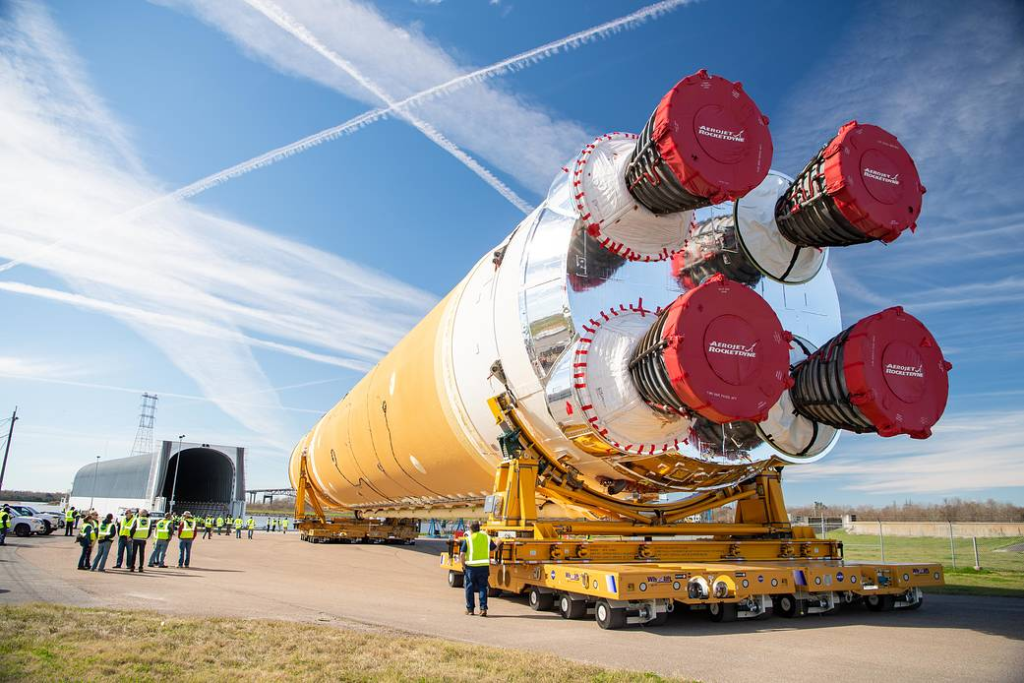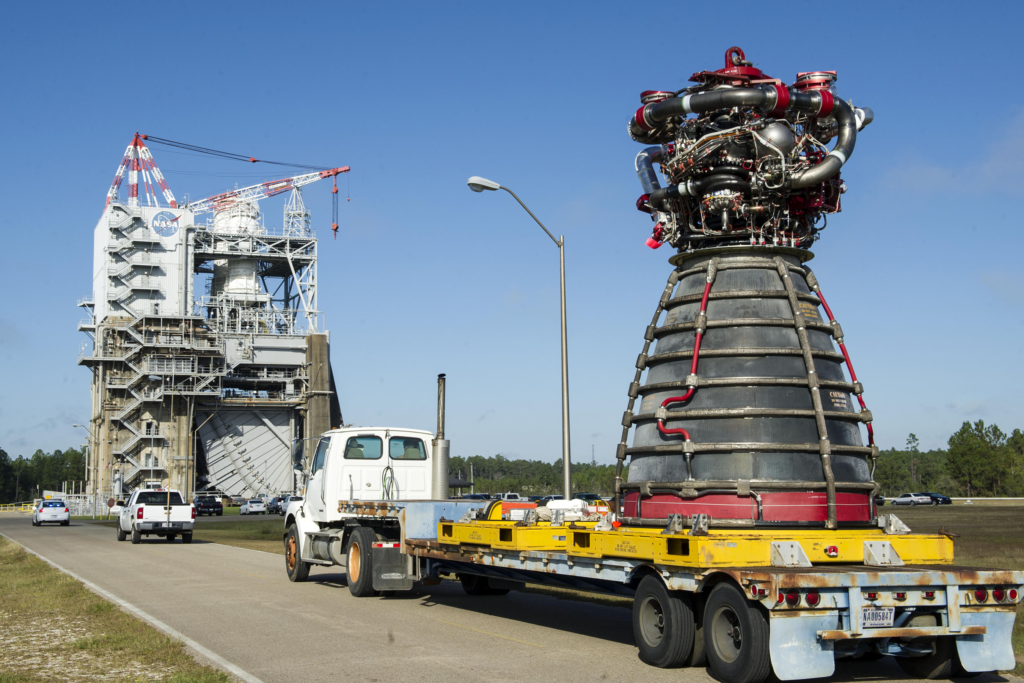
The Problem With NASA’s “New” RS-25 Engine
The core of the Artemis program and one of the most expensive aspects has been the Space Launch System (SLS) rocket. In particular, the RS-25 engines, which were used decades ago on the Space Shuttle have cost a lot. All the way back around 2015 NASA awarded Aerojet Rocketdyne a combined total of $5.7 billion apart of a Restart and Production program, meant to upgrade and produce a certain amount of engines.
While enough engines were completed and delivered for SLS’s maiden flight not long ago, the future is looking a bit shaky based on new information. Specifically, the NASA Office of Inspector General just released a full 56-page report on both SLS booster and engine contracts. This report not only highlights that there could be delays in the future, but the amount of money spent was extremely high.
This is a big deal as the RS-25 engine is necessary in order for Artemis II, III, and beyond to lift off with the first crews aboard. Here I will go more in-depth into this initial contract, what exactly went wrong with the engine, what to expect in the coming weeks, and more.
A Big Problem

To be specific, NASA initially awarded the company $2.1 billion under a program named “Adaptation” between June 2006 to September 2020, and $3.6 billion for the Restart and Production program, from November 2015 to September 2029. This was for the RS-25 engine which SLS uses four of on the first stage for a majority of its thrust. This being said, just yesterday on the 25th a full report titled “NASA’s Management of The Space Launch System Booster and Engine Contracts” was released. This report was completed by the Office of Inspector General which commonly comes out with information and is critical of the agency as necessary.
In the new audit, they examined the extent to which NASA is meeting cost, schedule, and performance goals for the Boosters and Adaptation contracts, and whether the RS-25 Restart and Production, the follow-on production contracts, reduce the government’s financial risk and promote affordability. In short, they don’t. In the very first sentence, they say “NASA continues to experience significant scope growth, cost increases, and schedule delays on its booster and RS-25 engine contracts, resulting in approximately $6 billion in cost increases and over 6 years in schedule delays above NASA’s original projections.
These increases are caused by long-standing, interrelated issues such as assumptions that the use of heritage technologies from the Space Shuttle and Constellation Programs were expected to result in significant cost and schedule savings compared to developing new systems for the SLS. However, the complexity of developing, updating, and integrating new systems along with heritage components proved to be much greater than anticipated, resulting in the completion of only 5 of 16 engines under the Adaptation contract. They continued by saying, “While NASA requirements and best practices emphasize that technology development and design work should be completed before the start of production activities, the Agency is concurrently developing and producing both its engines and boosters, increasing the risk of additional cost and schedule increases.”
To add to all of this they said “Additionally, Marshall Space Flight Center procurement officials who oversee all four contracts are challenged by inadequate staff, their lack of experience, and limited opportunities to review contract documentation. Specifically, inadequate procurement management led us to question $24.5 million in payments to Northrop Grumman to resolve a disputed request for equitable adjustment (REA) of award fee payments.
Further, NASA used cost-plus contracts at times where we believe fixed-price contracts should have been considered to potentially reduce costs, including the addition of 18 new production engines under the RS-25 Restart and Production contract. In addition, contractors did not receive accurate performance ratings in accordance with federal requirements, such as the “very good” rating awarded to Aerojet Rocketdyne on the end-item Adaptation contract despite only finishing 5 of 16 engines. As a result, we question $19.8 million in award fees it received for the 11 unfinished engines which were subsequently moved to the RS-25 Restart and Production contract and may now be eligible to receive additional award fees.”
All of this information from the report is a very big deal and shows some of the deep flaws with these contracts and certain ways NASA runs things. A lot of what this report is highlighting is that NASA is paying different contracts an immense amount of money and barely getting anything in return when compared to the original contract.
For one last point they commented, “Faced with continuing cost and schedule increases, NASA is undertaking efforts to make the SLS more affordable. Under the RS-25 Restart and Production contract, NASA and Aerojet Rocketdyne are projecting manufacturing cost savings of 30 percent per engine starting with production of the seventh of 24 new engines. However, those savings do not capture overhead and other costs, which we currently estimate at $2.3 billion. Moreover, NASA currently cannot track per-engine costs to assess whether they are meeting these projected saving targets.”
The Future of SLS

While the information and quotes from the new report I just provided are not the most promising, there are ways NASA can redeem itself and try to keep the program on schedule. The Office of Inspector General gave the agency 8 different recommendations to fix these pressing issues. Here they said, “To increase transparency, accountability, and oversight of the SLS booster and engine contracts and NASA’s affordability efforts, and ensure duplicative award fees are not earned, we recommended NASA senior leadership: (1) assess whether the 18 new RS-25 production engines under the RS-25 Restart and Production contract can be adjusted to fixed price;
(2) identify procurement needs and resources available to address staff shortages at Marshall; (3) ensure Marshall officials comply with best practices for establishing and maintaining internal controls related to REAs, fiscal law, and appropriate internal and external engagement; (4) ensure appropriate separation of program and procurement actions and compliance with federal requirements for use of letter contracts, proper definitization, overpayments, and duplicative payments of award fees for modified scope and contracts; (5) update RS-25 production per engine cost estimates to include investments in production restart; (6) review and update BPOC’s scope of work and technical requirements needed to complete the respective periods of performance; (7) review BPOC’s definitization to ensure proper liquidation of funds paid under the letter contract; and (8) develop a separate non-fee bearing contract line item for completion of the 11 unfinished heritage RS-25 adaptation engines.
After providing a draft of this report to NASA management, the agency agreed with recommendations 1,2,3,6, and 7. Meaning they only partially concurred that they should update the RS-25 per engine cost and develop a separate contract for the 11 unfinished engines. Not only this, but the report was quoted saying, “Despite concurring and partially concurring with all eight recommendations, the Associate Administrator for Exploration Systems Development Mission Directorate’s and Assistant Administrator for Procurement’s response to the draft of this report stated that the directorate and program do not concur with the facts as presented in the body of the report. The Office of Inspector General finished by saying, “We take issue with this summary characterization and are disappointed that the Agency’s formal response failed to specify the facts with which it disagrees.”
Obviously, this report and mainly the response is concerning as there seem to be some major complications that aren’t being addressed. As far as why this engine needed to be upgraded and adapted, it’s extremely old. To put it in perspective, the RS-25 powered the space shuttle for over three decades and completed 135 missions. It is one of the most tested large rocket engines in history, with more than 3,000 starts and more than 1 million seconds of total ground test and flight firing time. It also is one of the oldest being used for around half a century.
NASA tested the first SLS flight engine on March 10, 2016. Altogether, the agency has conducted 32 developmental and flight engine tests for a total of 14,754 seconds – more than four hours of cumulative hot fire – all on the A-1 stand at Stennis. During the Shuttle Program, the RS-25s routinely operated in flight at 104.5% of their original 100% rated thrust level but were tested up to 111% thrust. To meet the demands of SLS flight, more power and performance would be required. In the future, we can hope to see more engines produced and SLS stay on time with each of its components. Something much easier said than done.
Conclusion
The NASA Office of Inspector General just put out a significant report with some alarming findings related to both the SLS booster and primarily the RS-25 engines. Despite the information and recommendations provided, it seems like NASA management does not fully agree with most of what was said. This could have a big impact on the future of Artemis and returning humans to the Moon. We will have to wait and see how it progresses and the impact it has on the space industry.
Carry 2nd & 3rd stages will a big plane as high as it can go then pick up the 2nd & 3rd stages with a jet fighter and take it to higher altitude and Mock 3 and release it. Replacing 1st stage.
Carry 2nd & 3rd stages with a big plane…